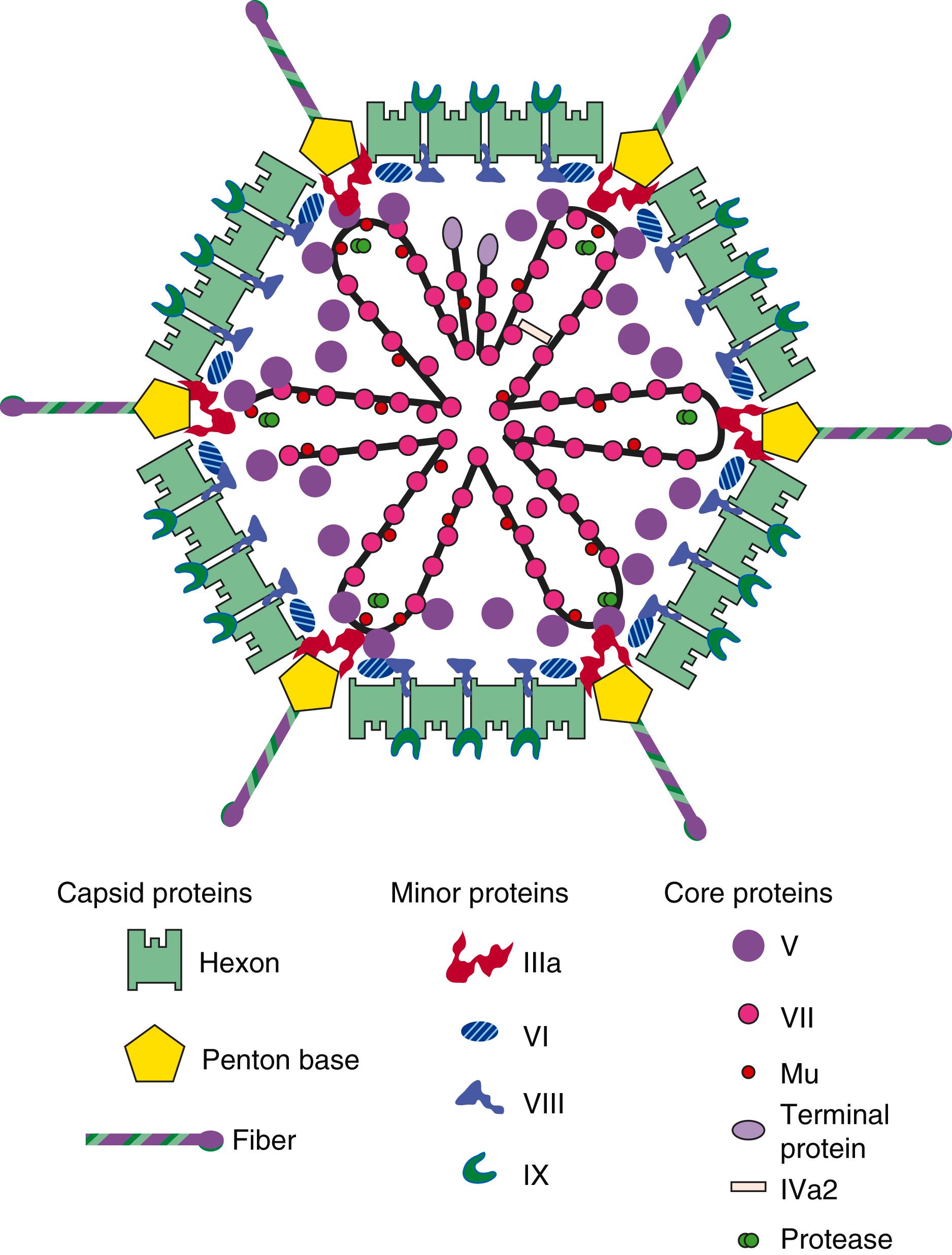Physical Address
304 North Cardinal St.
Dorchester Center, MA 02124
Human adenoviruses, which are members of the Adenoviridae family and the Mastadenovirus genus, are divided into seven species (A, B, C, D, E, F, and G; Table 333-1 ). Modern sequencing and molecular diagnostics have identified over 80 serotypes. Adenoviruses are double-stranded DNA, nonenveloped viruses that code for 20 early and 15 late proteins. The knobbed fiber protrudes from the fiber base ( Fig. 333-1 ).
| SUBGROUP | SEROTYPE | MAJOR SITE OF INFECTION |
|---|---|---|
| A | 12, 18, 31, ∗ 61 | Respiratory, urinary tract, gastrointestinal (GI) |
| B1 | 3, 7, 16, 21, 50, 68, 66, 68 | Respiratory, eye (including pharyngoconjunctival fever), GI |
| B2 | 11, † 14, ‡ 34, † 35, † 55, ‡ 66 | Urinary tract, respiratory |
| C | 1, 2, 5, 6, 57 | Respiratory, urinary tract, GI (especially hepatitis) |
| D | 8 § -10, 13, 15, 17, 19, § 20, 22-30, 32-33, 36, 37 § -39, 42-49, 51, 53-54, 56, 58-60, 62, 63-65, 67, 69-75 | Eye, GI |
| E | 4 | Upper respiratory tract infection, pneumonia |
| F | 40, ∗ 41 ∗ | GI |
| G | 52 | GI |
∗ Associated with infantile gastroenteritis.
† Associated with hemorrhagic cystitis and interstitial nephritis.
‡ Associated with epidemic pneumonia with high mortality rate.

Adenoviruses cause a range of infections from mild self-limited respiratory viral infections, conjunctivitis, and diarrhea to severe disseminated disease. Adenoviruses have a worldwide distribution, and infections occur throughout the year without significant seasonal variability. Most infections occur as sporadic events, although local or regional epidemics have been described. Asymptomatic respiratory infection is common and is associated with prolonged carriage, particularly in feces and tonsillar tissue. Most patients with adenovirus infection are children, generally younger than 5 years, and most individuals have serologic evidence of exposure to adenovirus by age 10. Only about 25% of symptomatic cases occur in adults. Adenoviruses 1, 2, and 5 are most common among children, whereas adenoviruses 3, 4, and 7 are more common in adults.
Severe outbreaks in the United States, including on college campuses, have resulted in cases requiring hospitalization, and nosocomial transmission can cause severe infections in health care workers. Adenovirus is the leading cause of respiratory viral infections among military recruits. Unlike the year-round circulation of adenovirus in civilians, peaks of disease are recognized within the first 4 weeks of training exercises among military recruits. Rates of adenovirus among military recruits declined significantly with widespread use of an oral live-attenuated vaccine in 1971, increased after supplies of vaccine were depleted by 1999, then declined again after an oral live-attenuated adenovirus type 4 and 7 vaccine was approved in 2011 ( E-Fig. 333-1 ).

Adenoviruses enter susceptible hosts by the mouth, nasopharynx, or ocular conjunctiva. The fiber protein of the virus binds to a cellular receptor that varies by serotype. On initial infection, local replication can induce considerable cellular damage owing to tissue invasive infection. Necrotizing bronchitis, bronchiolitis, interstitial pneumonia, and fibrin and hyaline membranes are seen within the alveoli during pulmonary infections. In ocular infections, exudative and mononuclear infiltrates develop beneath the epithelium. Replication results in desquamated epithelial cells, which induce hypertrophy in regional lymphatic tissue and active proliferative germinal centers. This reaction can cause swollen adenoids or intussusception ( Chapter 128 ) associated with enlarged mesenteric lymph nodes, particularly in children.
Components of both the innate and adaptive immune responses are important for the control of adenovirus replication. Alveolar macrophages and Kupffer cells help eliminate adenovirus from the lung and liver and also secrete inflammatory cytokines such as tumor necrosis factor (TNF), interferon (IFN)–γ, interleukin (IL)–1β, IL-6, IL-8, and IL-12. CD4 + and CD8 + T lymphocytes play a particularly important role in the control and clearance of replicating adenovirus in humans, and the absolute lymphocyte and CD4 + T-lymphocyte levels correlate inversely with adenovirus infection and the risk for developing disseminated adenoviral infections in immunosuppressed transplant patients.
Both group- and type-specific neutralizing and non-neutralizing antibodies are produced in response to infection and also play a role in limiting infection. Group-specific antibodies do not neutralize the virus but can confirm infection. Neutralizing antibodies may protect against disease manifestations in the previously infected host or against reinfection with the same serotype, but they do not eliminate the carrier state.
Adenovirus infections have a wide range of clinical manifestations that are linked to the virus type (see Table 333-1 ) as well as to the age and immunocompetence of the host. Common syndromes include infections of the respiratory tract, eye, gastrointestinal tract, genitourinary tract, and central nervous system (CNS). Disseminated infection also occurs, especially in immunosuppressed patients. Associations with adenovirus and obesity have been proposed as well.
About 10% of pneumonias in childhood and up to 5% of community-acquired pneumonias in some series of adults may be attributable to adenovirus, with adenovirus 7 probably carrying the highest risk for pneumonia. Typical symptoms include nasal congestion, coryza, and cough, which may mimic pertussis infections ( Chapter 289 ). Generalized malaise, fever, chills, myalgia, headache, and abdominal pain are common systemic symptoms. Exudative tonsillitis and cervical adenopathy are also seen. If conjunctivitis accompanies these signs and symptoms, the disease is designated as pharyngoconjunctival fever. Otitis media is a common presentation, particularly among infants under 1 year of age. Cases in children and in adults, especially military recruits, are indistinguishable from other viral respiratory infections such as influenza ( Chapter 332 ), parainfluenza ( Chapter 331 ), and respiratory syncytial virus ( Chapter 330 ). Recent outbreaks of sometimes severe and fatal adenovirus pneumonia have been described and should be kept in the differential in patients with severe pneumonia.
Become a Clinical Tree membership for Full access and enjoy Unlimited articles
If you are a member. Log in here